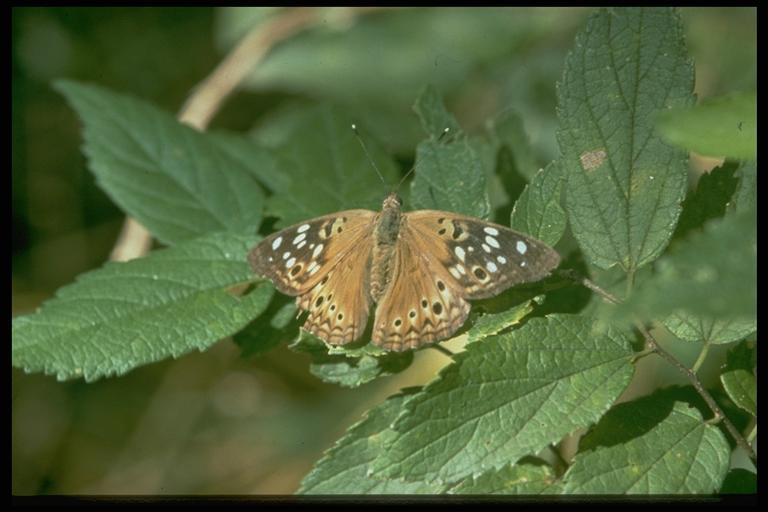
Hackberry butterfly, Asterocampa celtis (Boisduval & LeConte) (Lepidoptera:Nymphalidae). Photo by N. Mirro.
Common Name: Hackberry butterfly
Scientific Name: Asterocampa celtis (Boisduval & LeConte)
Order: Lepidoptera
Description: The adult is a medium sized (1-3/4 to 2-1/4 inch wingspan) yellow-brown butterfly with white spots near the fore wing tips and a band of dark spots and two dark lines following along the wing margin. Caterpillars grow to 1-1/4 inches long, are green, tapered at both ends, and marked with a pair of yellow lines along the top of the body and V-shaped markings on the sides. The head bears a pair of branched knobs and the end of the body has two projections or “tails.”
There are two subspecies in Texas; A c. celtis (Boisduval and LeConte) has one distinct dark spot near the margin of the fore wing, while A. c. antonia (Edwards) has two. Empress leilia, Asterocampa leilia (Edwards), in southwestern Texas is similar to A. celtis but can be distinguished by the two yellow-ringed black spots with white centers on the underside of the fore wings. The tawny emperor, A. clyton (Boisduval and LeConte) is similar to A. celtis, but is more dull orange to yellow-brown in color. It lacks the distinctive dark spot(s) and white markings on the fore wings. There are three Texas subspecies: A. c. clyton (Boisduval and LeConte), A. c. louisa (Stallings and Turner), and A. c. texana (Skinner). Caterpillars of these species also feed on hackberry, Celtis sp.
Life Cycle: Caterpillars hatching from eggs develop through several stages (instars) before forming a green chrysalis. There are three generations per year, overwintering primarily in the egg stage.
Habitat and Food Source(s): Caterpillars feed on leaves and tender new growth of hackberry trees (Celtis sp.). Adults are found on foliage, flowers near host plants, resting on the ground and feeding at tree wounds.
Pest Status: Very common butterfly on tree trunks and near hackberry trees; medically harmless.
See also Butterfly Gardening in Texas.
For additional information, contact your local Texas A&M AgriLife Extension Service agent or search for other state Extension offices.
Literature: Howe 1975; Neck 1996; Wright 1993.